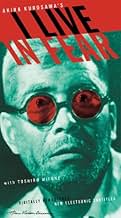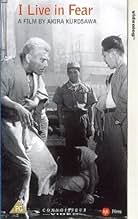An aging Japanese industrialist becomes so fearful of nuclear war that it begins to take a toll on his life and family.An aging Japanese industrialist becomes so fearful of nuclear war that it begins to take a toll on his life and family.An aging Japanese industrialist becomes so fearful of nuclear war that it begins to take a toll on his life and family.
- Awards
- 1 nomination total
- Yamazaki, Yoshi's husband
- (as Gen Shimizu)
Featured reviews
Mifune's performance is so very masculine and real, as are nearly all of them. In this film, he displays a self-assurance that allows him to descend into pathetic helplessness. Of all the post-war Kurosawa films that I've seen so far, I Live In Fear is the most direct and informative. America may feed off of the dread showcased by the Japanese culture in this film and some may feel terribly sad for the individualistic portrayal of the debilitating fear stricken into the immovable hearts of stubborn old men like Mifune's character.
Even as early as WWII, I learned, America's most powerful weapon has been fear. However, in those times, it was a much purer, less vain utility. But what about the people it destroys for the sake of its own feeling of security?
I should have known better. Part of Kurosawa's genius in his great middle period (1950-1965) is that he refuses to insist on anything. He fairly presents a series of events and invites us to decide what, if anything, they mean.
Everyone in this film has a point. No one here is really a villain. Even those who are jerks (notably the second son, Jiro) are really trying to do the right thing. And the film reminds me a little of THE CAINE MUTINY in that it very artfully moves our sympathies in one direction for most of the film before presenting us with events that make us wonder if we were wrong.
Toshiro Mifune gives a fine performance as Nakajima, but to tell the truth, I wish Kurosawa had given the role to Takashi Shimura, not only because I think Shimura would have played the role even better, but because it would have given him one more tour-de-force leading role in a Kurosawa film, coming directly after IKIRU and SEVEN SAMURAI. Granted, though, that such a move probably would have caused problems with both Toho and Mifune.
Here we have seventy-year old foundry owner Nakajima played by thirty-five year old Toshiro Mifune, who is so obsessed with the threat of a nuclear holocaust that he plans to sell up and move his extended family, including two mistresses and their offspring, to South America. His family's attempts to have him declared mentally incompetent have the most dire and tragic consequences for them all.
Apart from his ill-conceived and interminable version of Gorky's 'Lower Depths', the consistent quality of Kurosawa's work throughout the fifties and sixties is both staggering and unparalleled.
Unsurprisingly this gloomy opus was a commercial failure and had to wait six years before being shown at the Berlin Film Festival. A further six years were to elapse before its theatrical release in America. It still remains mystifyingly underrated.
All of the acting kudos has been reserved of course for Mifune who is mesmerising in the role. It is such a pity that he and Kurosawa parted company in the late sixties as theirs was a partnership made in heaven.
Every character in this is beautifully drawn and one cannot fail to mention Kurosawa regular Takashi Shimura as domestic mediator Harada who is consumed with guilt and remorse over Nakajima's fate. This comes three years after his own stunning performance in 'Ikiru' for the same director. Ironically he appeared a year earlier in another film dealing with fear of a nuclear holocaust, 'Godzilla', which naturally cleaned up at the box office.
The touches of a master film maker are here in terms of sound effects, editing and grouping of actors. The constant mopping of brows and waving of fans captures perfectly the unbearable heat and of course a Kurosawa film would not be complete without a torrential downpour or two.
This is an immensely powerful work which raises so many issues not least of which is the thin dividing line between rational/irrational behaviour. Does Nakajima 'go too far'? Many would say 'yes'.
It is Nobuo Nakamura as the psychologist who has the most telling speech when asking: "Is he crazy or are those who are unperturbed in an insane world the crazy ones?"
The final shot of the disconsolate Harada trudging down the stairs of the asylum whilst one of Nakajima's daughters, with child on back, walks up to visit her deranged father, is one of cinema's most devastating endings.
In a world presently paralysed by fear and paranoia this timeless film is ripe for rediscovery.
But this is not a one-issue film. Kurosawa also rails against the problems in a typical patriarchal Japanese family both with the family elder's demanding control over his children and also the younger generation's disrespect for the old man. However, an overarching theme seems to be an attack on individualism. Niide, the patriarch seeks only to save himself and his family. Throughout the picture we are reminded that there is a wider society out there, beginning with the opening shots of crowded streets scenes (which remind me of the beginning of The Public Enemy). So Kurosawa puts several of his political eggs in I Live in Fear's basket, but the points are skilfully woven together around the theme of the nuclear threat.
While we aren't confronted with an actual demonstration of the effects of nuclear war, the imagery of total destruction is there in subtle ways. The iron foundry which Niide owns resembles a ruined, burnt out city. At one point, Niide is startled by the beginning of a thunderstorm the perfect metaphor for a nuclear strike; a flash, a boom and rainfall (in other words, the radioactive fallout after the explosion). It's a slightly obvious device, but the timing is perfect. One of the most haunting images comes towards the end, in a scene where a dusty wind is blowing through Niide's house, flapping through the pages of a book he has left open on the floor.
Kurosawa's regular leading man Toshiro Mifune is daringly cast as the elderly Niide. With makeup ageing his features, the thirty-five year old is in a role unlike any he had played before. He's perhaps a little too lively to convince as an old man, but what counts is that he brings as much power to the performance as he did to his role as Kikuchiyo in Seven Samurai the previous year. His standout scene is the one in which he confronts Dr Harada after getting off the bus, and confesses that he is now terrified. Kurosawa cleverly amplifies his speech by having it take place under a road bridge. Kurosawa's favourite supporting actor, Takashi Shimura, plays Dr Harada, and turns in a strong performance as a kind of consistent voice of reason throughout the picture.
One criticism I sometimes have of Kurosawa is that in his effort to make a point, he occasionally forgets to make a film enjoyable for the audience, and this is somewhat the case here. I Live in Fear is not the most entertaining of Kurosawa's pictures. On the other hand, it's not all that long, and there's a slightly hysterical tone to it that occasionally makes it spellbinding. Kurosawa said this was the picture that he was most proud of, and you can see why. It was a flop at the Japanese box office, and has never been all that popular, but as a record of the atmosphere of the times, it really deserves more recognition.
Did you know
- TriviaToshiro Mifune was 35 years old when he played the role of a 70 year old.
- Quotes
Domestic Court Counselor Dr. Harada: His only fault is going too far. But his anxiety about the bomb is something we all share. Mr. Araki, Mr. Hori, Miss Tamiya -- you all know the feeling. Isn't that true? We just don't feel it quite as strongly. We don't build underground shelters or plan to move to Brazil. But can we claim that the feeling is beyond comprehension? The Japanese all share it, to greater or lesser degrees. We can't dispense with it so easily by just saying he went too far.
- ConnectionsFeatured in Mark Kermode's Secrets of Cinema: Disaster Movies (2019)
- How long is I Live in Fear?Powered by Alexa
Details
- Release date
- Country of origin
- Language
- Also known as
- Chronique d'un être vivant
- Filming locations
- Toho Studios, Tokyo, Japan(Studio)
- Production company
- See more company credits at IMDbPro
Box office
- Gross US & Canada
- $46,808
- Opening weekend US & Canada
- $15,942
- Jul 28, 2002
- Gross worldwide
- $47,023
- Runtime
- 1h 43m(103 min)
- Color
- Sound mix
- Aspect ratio
- 1.37 : 1


































